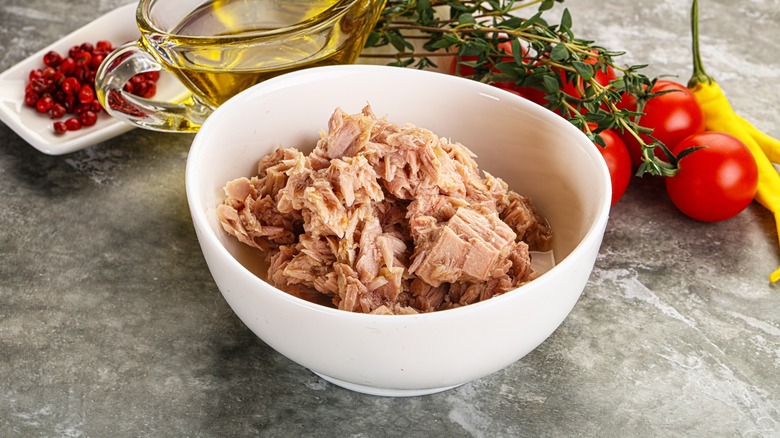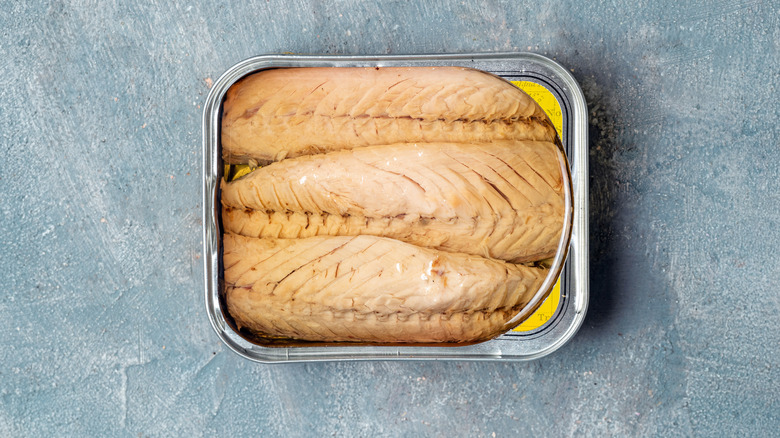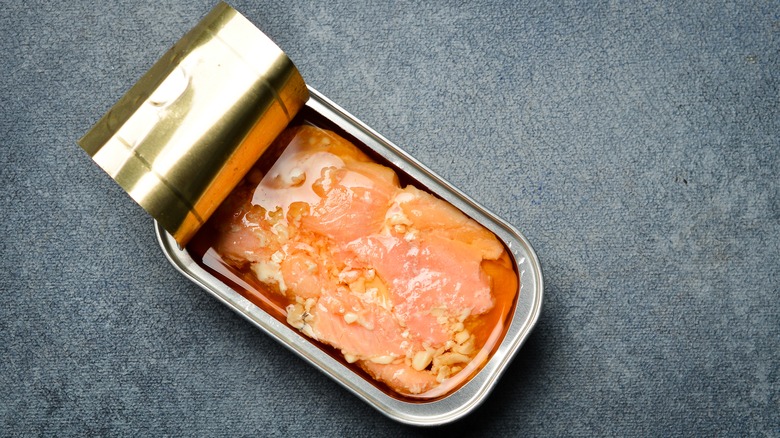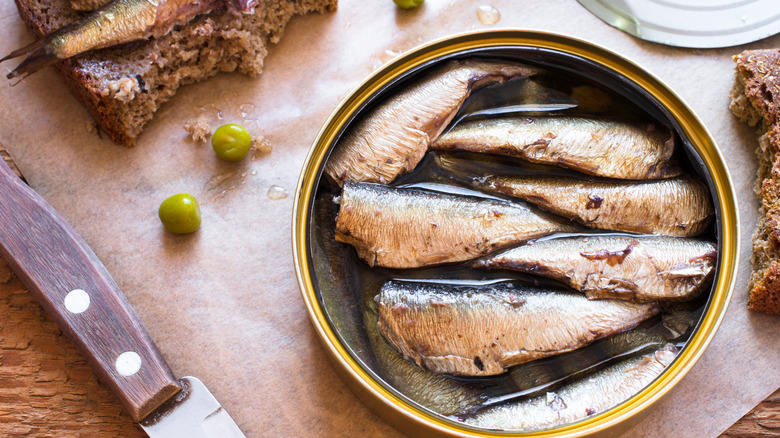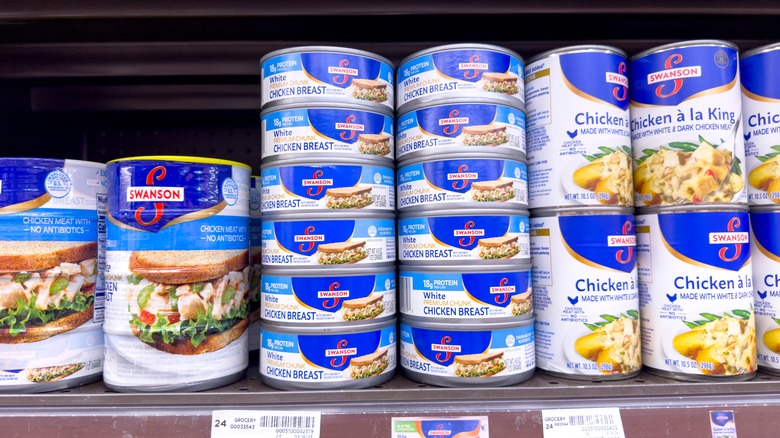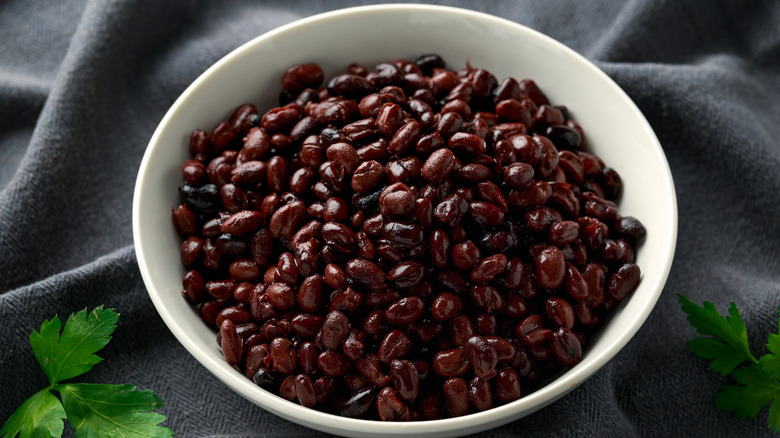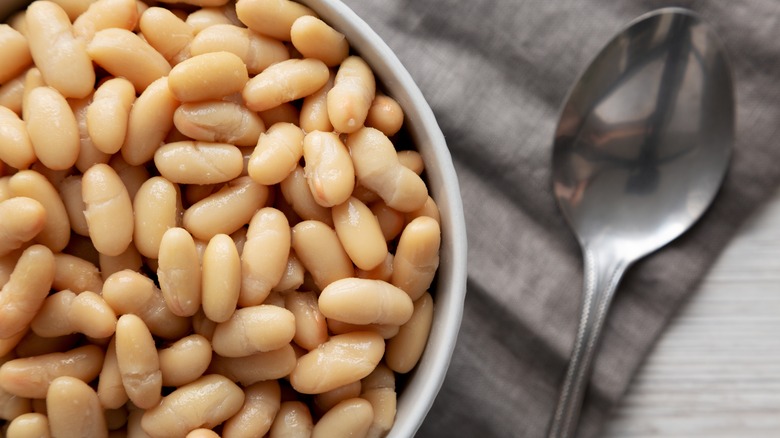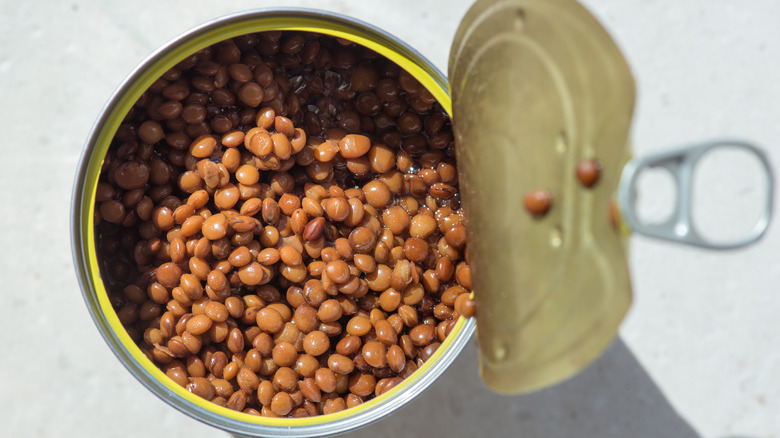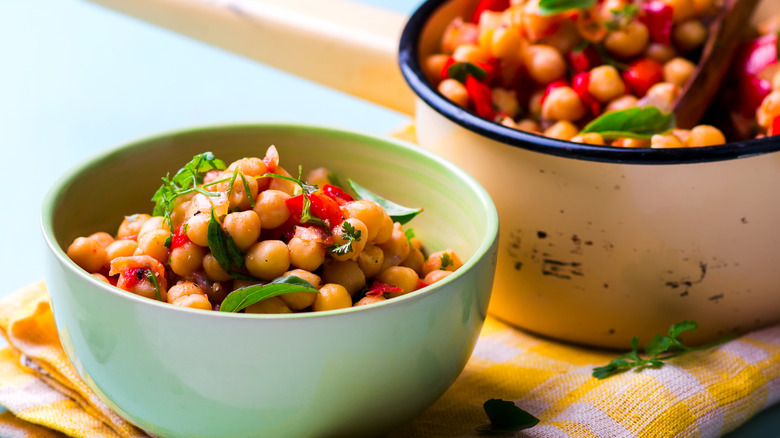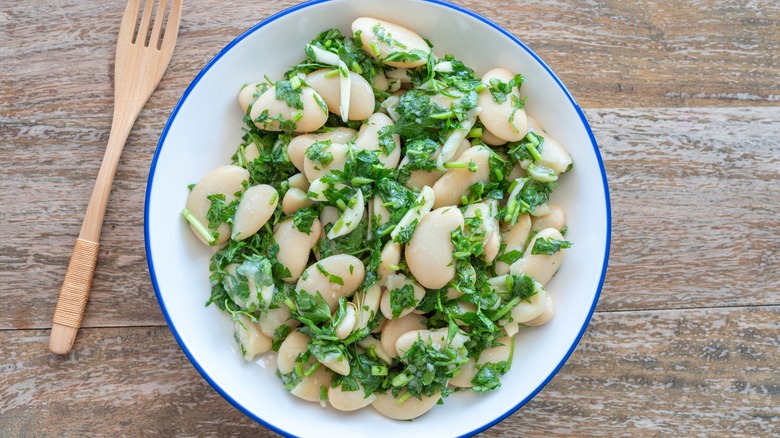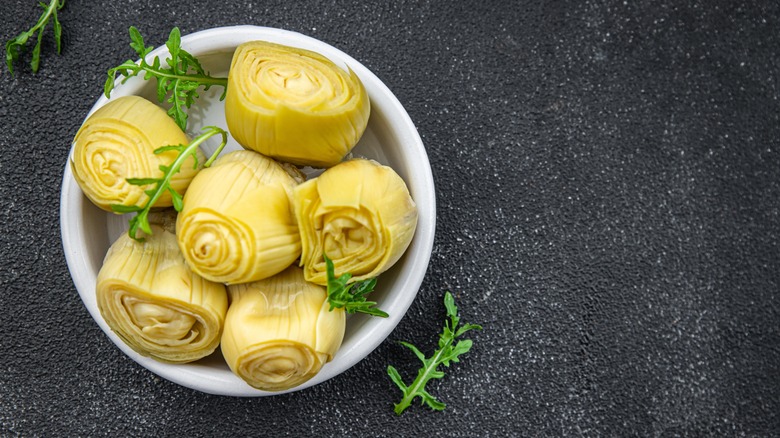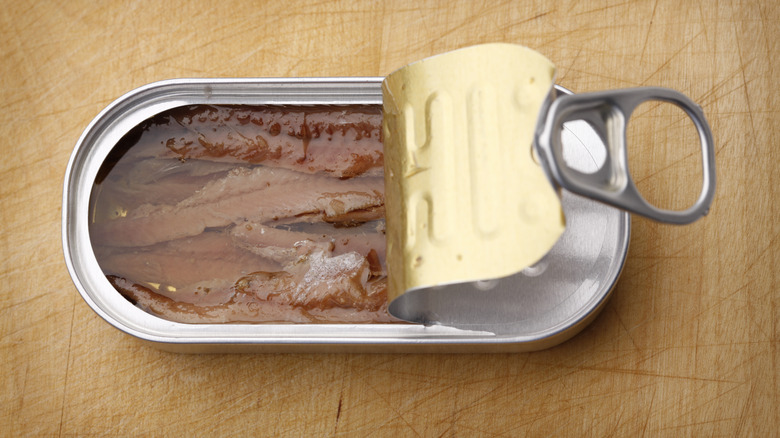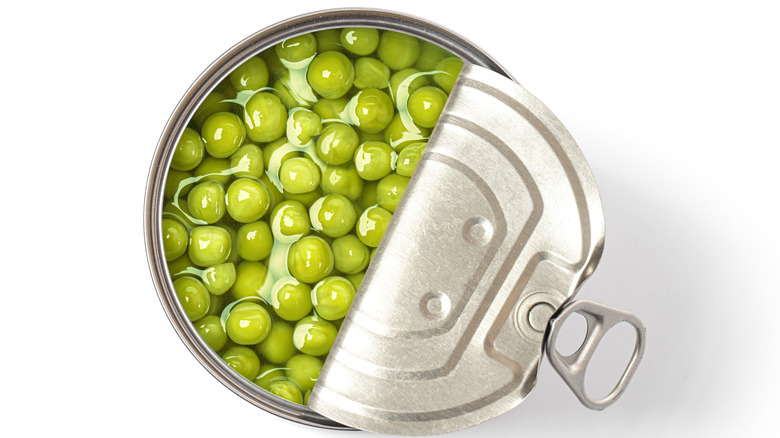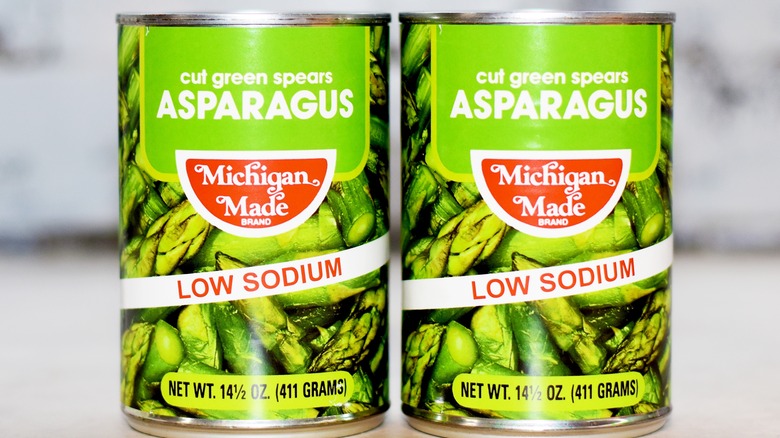14 Canned Foods That Are Packed With Protein
You don't need to be a bodybuilder to care about how much protein you consume each day. Protein plays a huge role in your health, helping you not only build muscle, but also repair cells and fight off illness via a protein-supported, robust immune system.
There are many ways to get your necessary protein each day through a balanced diet. However, oftentimes when we think of protein, we think of getting it through a handful of staple foods like lean chicken, fresh fish, eggs, and high-protein dairy like Greek yogurt or cottage cheese. While all of these foods are tasty and easy enough to incorporate into your diet, they do come with a few downsides. Some can be out of budget for some shoppers (hello, fresh eggs and seafood). Others, like raw chicken, may require more time in the kitchen than you might want to spend. Not to mention, fresh meat, dairy, and eggs all need to be refrigerated and have a limited shelf life.
Enter, canned sources of protein. There are plenty of canned foods that provide you with a hefty portion of your daily protein, while being shelf-stable and long-lasting; requiring minimal, if any cooking; and being pretty cheap, too. Here are some of the best canned foods that are packed with protein, and some ideas on how to start using them on a regular basis.
Tuna
Yeah, yeah, tuna is an obvious choice, but when it's so cheap and so protein-rich, how can we overlook it? A basic can of tuna can often pack in more than 20 grams of protein per just a 5-ounce can, meaning you're getting a lot of protein in a small portion size — and some brands offer more protein than others. For example, Wild Planet's albacore wild tuna provides 33 grams of protein per a one-can serving, which accounts for ⅔ of your daily recommended protein intake. StarKist's EVOO-packed solid yellowfin light tuna provides a still-respectable 29 grams of protein per can.
Try some of the top canned tuna brands for the best mix of taste, texture, and sustainability. In addition to Wild Planet, favorite brands include Ortiz, Safe Catch, Northern Catch, and TonNino. You can, of course, just pop open the can and eat the tuna as is, but start incorporating it into other recipes as well. Beyond a tuna salad, other genius uses for that can of tuna in your pantry include turning it into a fancy brandade (a Mediterranean-style dip that combines fish with mashed potatoes) or turning out some super-fast, super-simple tuna tacos or tuna pasta.
Mackerel
Mackerel may not get as much love and attention as salmon, but you may want to consider going out of your way to eat more mackerel, the next time that you're given an option between the two. According to University of Cambridge research from 2024, as published by SciTechDaily, eating wild mackerel rather than farmed salmon could result in greater nutrient intake, as well as a more sustainable fishing industry. Depending on the brand of mackerel purchased, those nutrients you could enjoy with each serving could include 20 grams of protein, 12% of the iron you need per day, 15% of the calcium you need per day, and 31% of the vitamin D you need per day — plus a hefty amount of omega-3 fatty acids.
Some of the best ways to use canned mackerel? Eat it as is, as a snack (use the oil the fish comes in as a dip for your bread, alongside the mackerel). Incorporate it into pasta dishes. Serve it on rice.
Salmon
If you're intimidating by cooking fresh fish at home, but love ordering salmon when you dine out at restaurants, just start by incorporating this protein-rich canned food into your life in simpler ways, no cooking required. As is the case with many canned fish, the amount of protein you get per serving of canned salmon will depend on the exact brand, but, for example, Wild Planet's canned tuna offers you 12 grams of protein per 2-ounce serving. In about a 3-ounce serving, Bumble Bee's pink salmon gives you 18 grams of protein, plus ¼ of your daily recommended vitamin D.
You can eat canned salmon right out of the can with no worries whatsoever, using it as a salad topping or in a sandwich (or just eaten as is). However, you can also incorporate it into a variety of dishes. For example, some of the best ways to use canned salmon include turning the salmon into salmon patties by combining the salmon with bread crumbs, mayo, mustard, eggs, and herbs; forming patties; and then pan-frying them. You can also incorporate the salmon into a chowder or quiche.
Sardines
Tinned fish seems fancy, but you can stock up on cans of sardines for as little as $1 per can. Eat the whole can and you'll get 18 grams of protein and 15% of your daily recommended calcium. One of the best parts, though? Sardines, due to their small size, are actually the fish with the lowest mercury levels, so if that's something you're worried about when adding more fish to your diet, you have even more reason to pick up some canned sardines during your next grocery run.
Beyond just eating these tasty tiny fish with crackers, or adding them to a sandwich, consider incorporating them into your favorite pasta dishes or using them on a salad. You can even pop some canned sardines in your air fryer for a crispy snack. All you have to do is toss the fish in flour or starch to create a crispy outer layer, and then place them in the fryer at 400 F for less than 10 minutes.
Chicken
No, we are not recommending you chow down on a whole chicken in a can. No one should have to go through that. However, you should pick up some canned chicken breast, which can give you 18 grams of protein per can. While canned chicken isn't as cheap as sardines or beans, it is very convenient. There's no cooking or refrigeration required, and you can incorporate the chicken into a salad, sandwich, pasta, or soup with ease. If you're looking for a more creative use for your canned chicken, consider making homemade chicken fries. The texture of canned versus fresh chicken makes for easier fry-shaping and then frying.
If you are not accustomed to using canned chicken very often, though, don't be surprised if you pop open your first can to find it's a bit unusually pink. Canned chicken is sometimes pink, but totally safe, as it's fully cooked. In fact, the pink color will typically fade and you'll have more a of a "normal" beige chicken color after about 10 minutes, as the chicken is exposed to the air.
Black beans
With 8 grams of protein per serving, plus 9 grams of fiber, and a nice amount of iron and potassium, black beans deserve a spot in your pantry. They're versatile and cheap, too. In fact, one could argue that black beans are particularly a good depression food: something nourishing and healthful that you can prepare with very minimal effort, on the days that your mental health just isn't making you the most productive. Snap open the can and give them a rinse, heat them up, and you're good to go. Of course, those beans will taste better if you add in some seasoning. Something as simple as cumin, paprika, salt, and pepper are enough, but you can take things further by incorporating black beans into just about any meal, for the extra protein.
There are even some pretty interesting swaps you can make — like swapping out pasta for beans. With any favorite pasta dish, literally swap the pasta for beans, tossing the legumes in your sauce of choice.
Cannellini beans
Cannellini beans are somewhat softer and creamier than black beans, but they're still quite affordable and chockfull of nutrients, with 7 grams of protein and 6 grams of fiber in every ½ cup serving.
Due to their softer, creamier texture, cannellini beans especially work well when swapping beans out for pasta. Don't want to give up your pasta? Pair your cannellini beans with the pasta by making pasta fazool — aka an Italian-American take on pasta fagioli that combines cannellini beans with tomatoes, pancetta, pasta, and spinach in a tomato-y, chicken-based broth. Have several cans of different beans on hand? Make a bean salad. Eat the beans as they are, with a little seasoning, for an easy side dish or simple meal. Just make sure, all the while, that you're avoiding the most common mistakes that you might be making with canned beans, including not rinsing the beans, overcooking the (already cooked) beans, not balancing your seasoning, and not storing them correctly.
Lentils
A member of the legume family, lentils may not be the first canned legume you reach for, but they offer a decent amount of protein — 7 grams — per serving, alongside 10% of your daily iron requirements and 11% of your daily fiber requirements. At 110 calories per serving and around $1 per can, you really can't go wrong.
So how can you use more lentils in your life going forward? While a lentil soup is a favorite option in the winter, don't restrict yourself to this one dish. Lentils, for example, make an excellent ground meat replacement. Add a packet of taco seasoning and you have a great swap for ground beef in your tacos, tostadas, or enchiladas. Throw in some Italian seasonings and add lentils into your pasta sauce instead of ground beef or sausage. You can even just simply add some lentils to your salad, for extra protein.
Chickpeas
Much like beans, chickpeas come with a bevy of benefits at an incredibly affordable price. At less than $1 per can (so about $0.25 per serving), chickpeas will give you 6 grams of protein, 6 grams of fiber (so about ⅕ of your daily recommended allotment), and only 120 calories. What's not to love?
Plus, there are so many ways to use chickpeas. Yes, of course, you can make homemade hummus, but that's just where the magic begins. If you have an oven or air fryer, you can also make crispy chickpeas, a delicious snack or side dish. Trying to get more protein as a vegetarian or vegan? Chickpeas also make an ideal vegan chicken substitute, particularly in dishes where the chicken is paired with more dominant flavors; think casseroles, pasta dishes, soups and stews, or chicken salad. The same can be said for using chickpeas in place of tuna.
Lima beans
Why do lima beans get such a bad rep, when they offer such health benefits? From the 6 grams of protein to the 4 grams of fiber, 15% of your daily vitamin C to the 10% of your daily iron, lima beans offer a lot to appreciate in each ½ cup serving. Maybe you just need to think of lima beans not as "lima beans, the food you were forced to eat as a child and that probably wasn't cooked all that well" but as "butter beans." That's right — lima beans and butter beans, which are arguably trendier, are the exact same bean.
Butter beans had a moment a few years ago, with vegans and vegetarians on social media singing the beans' praises. Particularly, it became common to find foodie feeds filled with butter beans simmering in a thick, creamy base of some sort of reduced broth, maybe some cheese, and a few other vegetables, like spinach or tomatoes, and then served alongside toast as the ultimate in healthy cozy comfort meals.
So, if you have a hard time accepting the lowly lima bean as a protein-rich part of your diet, change your thinking. It's not an "ew" lima bean — it is a glamorous butter bean.
Artichokes
You might not think to look to artichokes for your protein, as these vegetables definitely aren't as famed for their protein content as legumes, but they can still give you a nice 6 grams of protein per 13-ounce can, along with 7 grams of fiber and 10% of both your daily iron and daily potassium.
While canned artichokes might not be as good as fresh or jarred for certain uses (some people do not like the texture of canned artichokes, but you can get around that somewhat by finely chopping the artichokes), you can still find many great ways to use up a can of artichokes. For example, use them as a topping for your chili fries. They add an earthy saltiness that's hard to replicate. You can also deep-fry canned artichokes after coating them in cornstarch, and then add them to your pasta salad (or any salad, really) for texture. Bake them into an artichoke casserole or an artichoke dip.
Anchovies
Anchovies may be more expensive than sardines, but nothing can match the umami power of an anchovy. That's what really sets anchovies and sardines apart. You also are not going to get as much protein in a serving of anchovies as you will in a serving of sardines, but when you start incorporating this versatile fish into your cooking, you likely won't even care. Anchovies offer you 4 grams of protein per serving, so about 8% of your daily value. Unfortunately, they can be high in sodium.
Regardless, you'll quickly see why anchovies are Bobby Flay's secret go-to ingredient, putting minced anchovies in his lobster macaroni and cheese, for example, as the cooking process negates the sometimes-polarizing fish's innate fishiness and texture, until it melts into a umami bomb. Similarly, Alton Brown includes anchovies in his tomato soup. From pasta and salad dressings (including, obviously Caesar, but you can also make a delicious anchovy vinaigrette) to pizza and soup, anchovies find a place in them all.
Peas
With 4 grams of protein per ½ cup serving, plus 4 grams of fiber, canned sweat peas aren't very likely to help you meet your daily protein needs all on their own, but they can definitely help in a way that other veggies might not.
Even if you don't care to eat peas as a side dish, on their own, heated with some simple salt, butter, and seasonings, there are plenty of other uses for canned peas. Add them to a pasta salad. Throw them in a soup. Include them in a pasta sauce or similar dish; from basic buttered pasta to macaroni and cheese to carbonara, it will all welcome a healthy amount of peas. Making a casserole? Add in a can of peas. Looking for a light and spring-y appetizer? Make pea pesto, with peas, cheese, basil, nuts, garlic, and oil. Try potato pea curry for an easy, slow cooker-adaptable meal.
Asparagus
Admittedly, canned asparagus cannot stand up to fresh asparagus in terms of taste or texture. However, canned asparagus does come with the benefit of being both shelf-stable and pre-cooked. Canned asparagus comes with 2 grams of protein per serving, which, while not as much as you'll get from protein-rich vegetables, is definitely more than you'll get from other vegetables that contain no protein at all, such as celery, onions, and radishes.
So how can you use this asparagus to get the most out of a canned vegetable that needs a little extra attention to make up for its poor texture (that's all a result of the canning process)? Look to recipes that do not rely on the asparagus having a crisp, snappy texture. Instead, try a cream of asparagus soup or a casserole that includes asparagus, as well as other, similar baked dishes that include asparagus, like quiches or frittatas.

